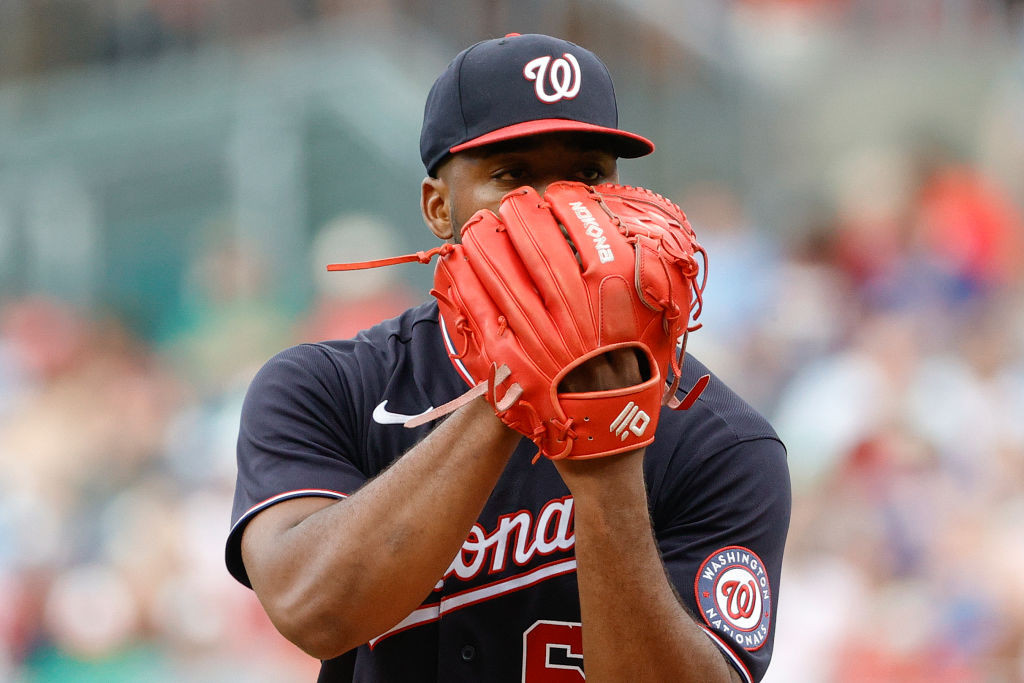The Nationals’ best hope for significant improvement in 2023 is through a significantly improved rotation. It’s really as simple as that.
The 2022 Nats rotation was awful. That group’s 5.97 ERA didn’t just rank last in the majors, it ranked last in club history. By leaps and bounds.
Only three previous times had the Nationals ended a season with a rotation ERA over 5.00: In 2006 (5.37), 2007 (5.11) and the pandemic-shortened 2020 campaign (5.38). Davey Martinez and Jim Hickey would’ve killed to get those kind of numbers last season, which tells you just how bad things were.
The organization, though, believes it is ready to take a big step forward in starting pitching. That belief is based in the hope that three young building blocks (MacKenzie Gore, Cade Cavalli, Josiah Gray) are ready to lead the way, taking pressure off Patrick Corbin and Stephen Strasburg to have to hold those responsibilities anymore. The offseason addition of right-hander Trevor Williams, in theory, should provide some stability at the back of the rotation.
It all sounds good on paper, but what are the odds it will play out as hoped in reality?
If you asked a team official for a plausible best-case scenario this season, it would include 30-plus starts apiece for Corbin, Gray and Williams, and 25 starts each for Gore and Cavalli (whose workloads will be more closely monitored because of their inexperience and injury issues last year). But is that actually realistic?
History suggests it’s probably not. Not because each of those five pitchers isn’t capable of making that many starts. But because it hardly ever works out that way for any team’s rotation.
Consider this: The Nationals only had three pitchers make at least 25 starts last season: Corbin, Gray and Erick Fedde (who was non-tendered earlier this winter and is now set to pitch in South Korea). And that wasn’t unusual. It was right in line with the major league norm.
Only six big league clubs saw four pitchers make at least 25 starts last year: the Astros, Giants, Phillies, Rays, Diamondbacks and Mariners. Only the Astros had five starters reach that mark. Seven teams didn’t even have three starters get there, including the 111-win Dodgers.
It’s not even that common in Nationals history. Only five times in their 18 seasons of existence have they had four or more pitchers make 25 starts. Unsurprisingly, all came during their 2012-19 window of success.
So while the fate of the 2023 Nats is very much in the hands of an improved rotation, we shouldn’t think of it as a five-man group. Martinez and Hickey are going to need several more starters to help out along the way.
Who, then, can they turn to when they need a sixth, seventh or eighth starter? At the moment, the rotation depth chart is headlined by a couple of swingmen who were more successful as relievers than as starters (Paolo Espino, Cory Abbott) and a young starter who struggled mightily last season before getting demoted to Triple-A Rochester (Joan Adon).
Beyond that, their options are woefully inexperienced. Jake Irvin was added to the 40-man roster this winter, but the 2018 fourth-round pick has yet to pitch above Double-A. Evan Lee and Jackson Tetreault each made his major league debut last season, but each suffered an injury and eventually was dropped from the 40-man roster. Cole Henry figured to be ready to make his debut this year, but the 2020 second-round pick is attempting to return from thoracic outlet surgery, and we all know how uncertain that process can be. Thad Ward is another potential option, though as a Rule 5 draftee he’s still to prove he deserves to make the roster out of spring training or else be offered back to the Red Sox.
Given all that, don’t be surprised if general manager Mike Rizzo attempts to sign a veteran starter or two to minor league deals with invitations to major league camp. Someone with experience who could be waiting in the wings to make the club if one of the planned five starters has an issue in spring training. Someone who would be willing to go to Triple-A if there isn’t an opening on Opening Day, recognizing the time will come before long.
Rizzo did it last year with Aníbal Sánchez and Aaron Sanchez. It wound up working out well for Aníbal, though it took until late summer to happen. It didn’t work out well at all for Aaron, who was dumped after seven ragged starts.
In a perfect world, the Nationals won’t need to rely on those types of starters much this season. The five projected starters would all stay healthy and pitch well enough to stick all year long.
Rarely, though, can a ballclub count on a perfect world.
By accepting you will be accessing a service provided by a third-party external to https://www.masnsports.com/





